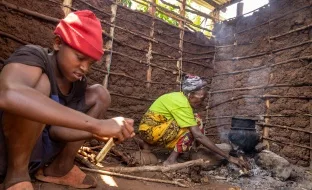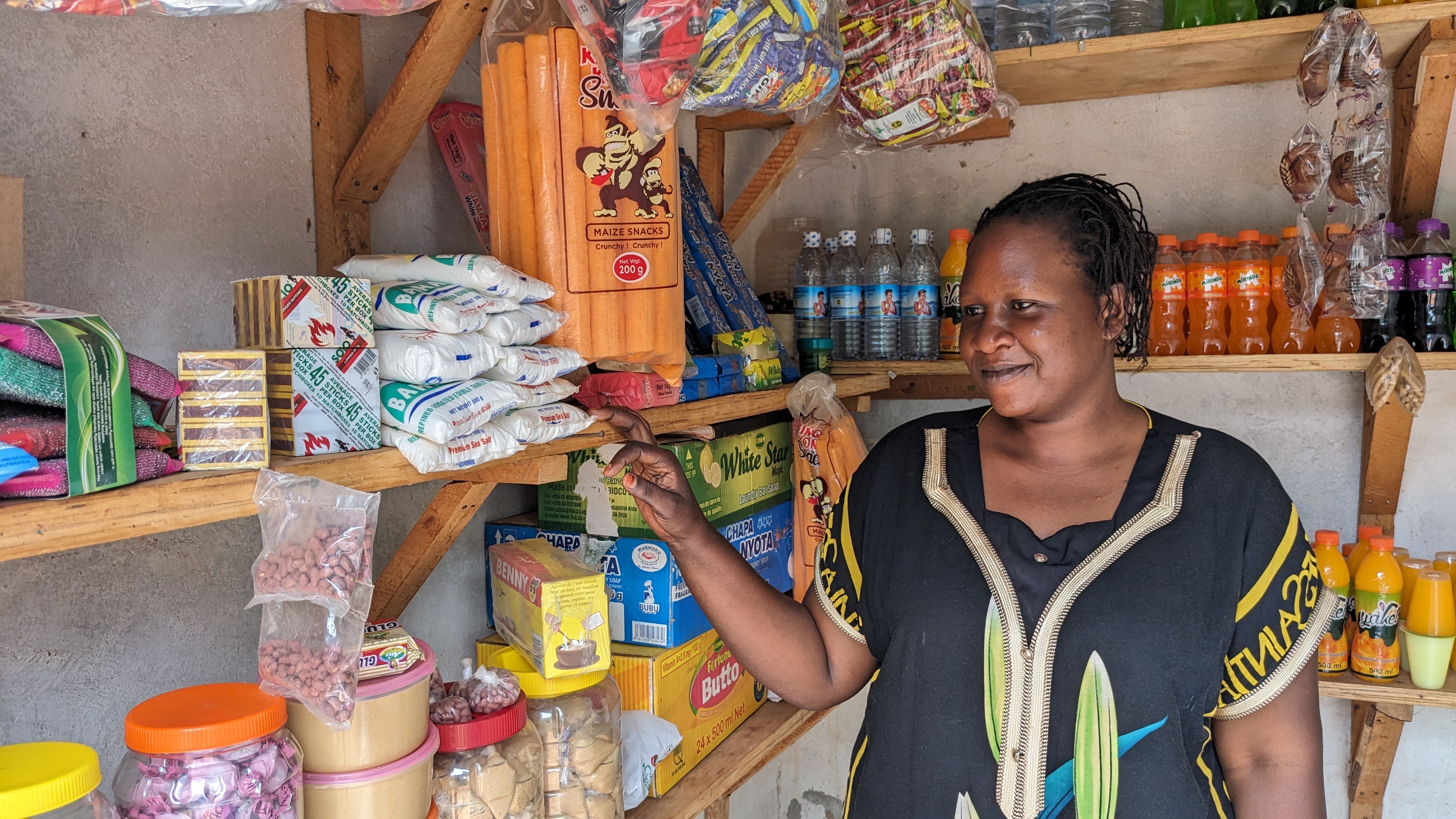February 2023 update
A newly published academic paper examining the preferences of low-income households in Kenya over the structure of GiveDirectly unconditional cash transfers found:
- Most prefer lumpier transfers, and many prefer delayed receipt—unlike the structures typical of safety-net programs, but consistent with evidence on the financial challenges of poverty.
- Poverty itself affects preferences: a little more financial slack when deciding increases desired delay.
- Financial slack pays back: some delay—aligning transfers better with the seasonal cycle—increases deliberation, income, and goal progress 1.5 years later.
In the past two years, 182 countries launched cash aid programs, recognizing the autonomy they provide people in poverty to make decisions for themselves. In many cases, however, aid recipients have limited control over exactly how they get their cash transfers. While the total amount might be fixed, the frequency and size of payments and the time it arrives are also determined by the program administrators, not the recipients.
Is a single $1000 payment difficult to manage, while 5 months of $200 payments helps with budgeting? Are mobile money transfers better in the morning before markets open or in the evening for planning tomorrow? These are questions aid organizations aren’t equipped to answer alone.
GiveDirectly usually provides one large payment paid in two equal parts, but also runs programs providing smaller recurring income payments. In either case, much of the program design has been based on what we and our donors prefer. However, our first value is “Recipients first: We prioritize recipient preferences over those of donors or ourselves.” This is why we’ve begun conducting preliminary research to establish what potential recipients would prefer for the size, cadence, and timing of their transfers. Our overarching goal is to align our operations as much as possible to meet the stated preferences of those we aim to help.
GiveDirectly held focus groups with past and future recipients to learn their preferences
This spring, we conducted focus group discussions to establish how people receiving cash aid would prefer to break down the total amount they were to receive and what timing they would choose to receive the cash if they were given free choice.
We asked the participants the following question:
“Imagine you were to receive the equivalent of $1000 in unconditional money and you had the freedom to choose the month(s) to receive it and how much you would receive each time. The only condition is that you can only receive the cash once in a given month and that you should have received all the cash 12 months from now. What would your preference be?”
The groups included 191 past and future GiveDirectly recipients – 91 from Kenya (31 past, 60 future), 52 from Malawi (16 past, 36 future), and 48 from Liberia (12 past, 36 future). Past recipients were aware that they would not be receiving any further cash transfers from GiveDirectly. Future recipients were not aware that their community was set to receive cash transfers this year.
Over two thirds preferred receiving payments over multiple months
80% of these participants wanted to space the installments out by three to four months
The vast majority of participants who preferred their $1000 be split over multiple transfers wanted to space the installments out by three to four months. Their reasons varied:
“I have chosen twice a year because I would want to plan it well rather than spending it at once when a lot of money comes at once it is confusing, I will need a break in between.”
Future recipient, Malawi
“I want to spread the money throughout the year. The first transfer in April then wait for 3 months then receive another until I have got all the money so that I can be able to plan properly.”
Future recipient, Kenya
“If the organization wants to give us aid then they should divide it into 2: one in the beginning of the year and another in the middle so that we do not struggle in the middle of the period.”
Future recipient, Liberia
“I have chosen to spread out the transfers because I would like to make plans than having them in lump sum I would have spent it anyhow”
Past recipient, Kenya
67% of these participants wanted at least half of the money in the first transfer
Most (67%) of the participants who preferred multiple installments wanted approximately half of the $1000 at the first payment. Like those who chose one lump sum, most planned to use the first transfer to address needs that required a large injection of money like land purchase, building and improving homes, paying for children’s education, buying livestock, and boosting existing business or starting new business.
“The foremost for me is to purchase a piece of land, which will cost me ~$595 per acre.”
Future recipient, Kenya
“My first goal is paying school fees which will cost ~$425.”
Past recipient, Liberia
Those who wanted a single lump sum mainly planned to make large capital investments
Home construction and improvements were the leading reason for a single lump sum. Others’ reasons included purchasing agricultural inputs and bulk stock for business.
“I have chosen to receive in one lump sum because when you have that huge amount of money at once, I can easily build a house and at the right time.”
Past recipient, Kenya
“I need all the money to invest in stock for my business before the roads are destroyed by the rains.”
Future recipient, Liberia
“I need all the money at once because I plan on doing a business, buying livestocks, finalizing harvest”
Future recipient, Malawi
Some chose a single lump sum to address multiple goals or problems simultaneously.
“As for my case, what if I want the whole amount because I want to all at once deal with my goals of purchasing a bed and a mattress, pay school fees as I have been for a long time struggling paying school fees right from my own children to now paying for my grandchildren, build my house with a water tank and gutters around the house to store rainwater. Will it be possible to get the whole amount at a go so that I can complete my goals?”
Future recipient, Kenya
“Getting all the money at once can solve all problems requiring finance at once.”
Future recipient, Malawi
“If I get all the money at once I will be able to build a house, prepare for another farming season, and buying food for the household.”
Past recipient, Liberia
Both groups preferred payments be timed around predictable futures needs
Weather patterns were the main cause but for several reasons. Seasonal weather patterns drive the timing of agricultural activities, which also affect the cost of food. Weather variations also matter for construction or transportation.
“I choose the dry season because it is the right time to buy seeds and fertilizer so that when the rains start, I am ready to plant.”
Past recipient, Liberia
“The dry season is the best time to buy tools and hire workers to cut bushes and till the land.”
Future recipient, Malawi
“Food is scarce and most expensive in the rainy season (planting and growing season). I need that money to afford the expensive food.”
Future recipient, Liberia
The school calendar also affected timing preferences.
“The academic year begins in September so parents want to register their children and do fees payment.”
Past Recipient, Liberia
Political events also affect timing preferences. In Kenya, the upcoming presidential elections played a critical role in recipients choice of timing. This is something we already plan around: we doubled our targets for enrollment before this year’s election period in preparation for then pausing operations in June, July, and August.
“We prefer to get the transfers as soon as possible since prices of items are getting higher each day. With the elections this year we don’t know what [it] holds for us hence we prefer the money comes sooner.”
Future recipient, Kenya
“With election season you never know what may happen. The prices of everything may shoot up or the people giving us the money may not be able to send the money.”
Future recipient, Kenya
95% of recipients preferred to wait a month or more before receiving their initial cash transfer
The most universal opinion among participants was not wanting to receive their transfers as soon as they were enrolled. Currently, we send money about 1 month after enrollment. When given the option to receive money instantly at enrollment, 95% of participants declined.
“I felt like I was under a lot of pressure. I wish we had been given some time to think and plan how to use the money.”
Past recipient, Kenya
This work is a first step in recalibrating our programs to better serve recipient preferences
These focus group discussions were just the first step to recalibrate our programs to more intentionally incorporate recipient preferences. These findings informed the design of a larger rigorous research project we’re running with academics from the University of Minnesota, Northwestern University, and UT Austin to answer three remaining questions:
- How deeply held are these preferences? As we recalibrate our programs, it’s important to not just know recipients’ preferences, but also which are the most deeply held. This forthcoming study will use the Willingness to Pay approach to establish recipients’ commitment to their choices – are participants willing to get a little less money in exchange for receiving it according to their preferences?
- Does redesigning programs to meet preferences improve dignity? Our goal is to increase respect for the dignity of recipients by centering their preferences in our program design. However, we cannot assume this will be the outcome. The study will use the IDinsight Dignity Project tool to learn how involving recipients in cash transfer decisions affects their experiences of respect for their dignity in receiving aid.
- How will design changes impact our program’s efficiency? We will also study the impact on our operations’ efficiency of paying recipients according to the preferences. Historically, only about 10% of a donation goes to the cost of administering our programs. If changes to our programs drive costs up, it means we’ll be able to reach fewer people in poverty – an important trade-off to consider.
We plan to launch this study in 2023 and will report back on our blog with our findings.

